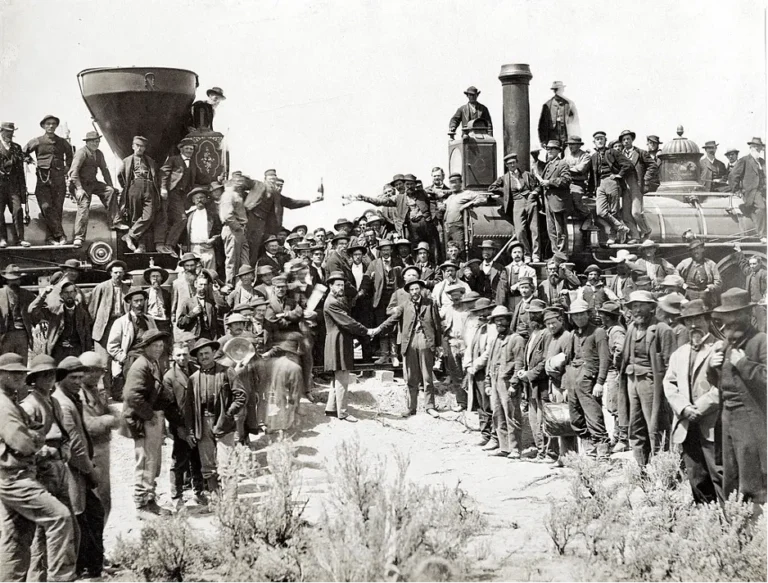The History Of The Railroad System Across The United States
Railroads in the United States were born out of the English Industrial Revolution and developed almost simultaneously with Great Britain. Within a few years, the first railway companies were established in the young nation – private, non-state-owned companies that by 1850 were operating almost 15,000 km of track.

Celebration of the meeting of the railroad in Promontory Summit during the construction of Transcontinental Railroad, Utah in May 1869
The Start
From 1860 to 1880 there was a boom in railway construction: the number of miles of track in operation in the United States tripled from thirty thousand to ninety thousand. Because the choice of route could mean the fortune of one area and the ruin of another, counties and states competed for railroads by granting valuable land, often on a competitive basis. Most of this land would be of no value until the areas were sufficiently populated and producing goods for transport, so the new railway companies encouraged colonization in the areas that crossed their lines, as new settlements meant an increase in passengers and an increase in the value of the government land that the companies had seized.
The settlement of the vast region between the Missouri and the Pacific was the most important result of the transcontinental railways, which attracted immigrants from eastern America and Europe seeking their fortune. Thousands of railway workers were granted title to land so that they could become permanent settlers once the railway was in operation. The population of the central and north-western states grew by leaps and bounds: Kansas and Nebraska multiplied by six in just twenty years, Utah tripled its population in the same period, and the new state of Colorado increased its population tenfold. With the union of the two coasts in 1869, North American railways took on the structures that would characterize them well into the 20th century. Railway companies were private, each building its own tracks and operating its own trains. The networks could be interconnected and one company could use the other’s network by paying a toll. This did not happen between directly competing companies, which sometimes went so far as to duplicate lines in order to damage competition, but the rule was that each busy route was served by more than one company.
The 20th Century
At the beginning of the 20th century, there were about 200,000 km of railway lines in the United States. Between 1917 and 1920, as a result of the First World War, rail transport in the United States was nationalized and the United States Railroad Administration was created. This large national company put many steam locomotives into service, modernizing the rolling stock of the smaller railway companies. The vast expansion of the railway network, with considerable distances to be covered, especially for the “western” lines that had to cross deserts and the Rocky Mountains, meant that the US industry was at the forefront of railway technology, and the three major locomotive manufacturers, ALCO, Baldwin and Lima, sought new construction methods to make their products more competitive. All North American steam locomotives were very robust, powerful machines with multiple pre-heaters and water and steam injectors along the boiler, features that were unusual compared to the more balanced European machines. This was because in North America, for both economic and practical reasons, traction equipment had to meet criteria of robustness and reliability. In the 1930s, the characteristic streamlined bodywork of locomotives and trains was introduced by the major companies, more for advertising than for technological reasons. For freight trains, the Mallett articulated locomotive, first with double and then with single extension, became popular, especially on mountain passes.
The Railroad System Today
While freight traffic reached its peak with the Second World War, the golden age of the big US companies soon began to fade. The rise of the automobile and, above all, the airplane slowly eroded the need for trains, especially on transcontinental routes. In fact, the big passenger companies, such as NYC and PRR, went into crisis, while the freight companies were saved. From the 1970s onwards, passenger transport was taken over by the government-owned Amtrak because it was economically unviable. The private railway companies then concentrated on freight transport, initiating various mergers between themselves, which resulted in the arrangements that still exist today. On the mechanical side, the traditional railway manufacturers disappeared in the early 1950s with the advent of diesel traction, replaced by the Electro-Motive Division and GE Transportation Systems (General Electric Group). Unlike in Europe, electrification never took off in the United States, except on a few specific routes. This was for economic reasons: electric traction is more expensive than diesel traction.
Conclusion
The US railways may be one of the least travelled forms of transport today, but they were the driving force behind the economic growth of the United States in the 19th century, connecting the vast expanses of the country and facilitating the movement of goods and people on a large scale. The rail network allowed natural resources, agricultural products and manufactured goods to be moved efficiently, opening up new markets and stimulating industrial development. The ability to quickly reach both continental coasts encouraged the birth and development of many cities in the center of the states, helping to create the great power we know today.
